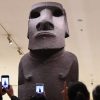ART NEWS
Walking through verses at the new museum of poetry
The museum in Italy launches its first exhibition on September 26, curated jointly by Kannada poet Mamta Sagar and Italian poet Antje Stehn
Someone once said that we put things in a museum to take them out of the world. But John Keats, who in his short life worked to perfect the art of poetry, referring to his poem Ode on a Grecian Urn, said: “Objects are better historians than we are. They hold truths. They tell stories. They capture history, forever.” In his poem, Objects, poet W.H. Auden, who engaged with politics, religion and love, declares that objects “make time more golden than we meant to tell”.What would it be to museumise poetry? Poetry by its very nature is an experience, but to museumise it would mean that it becomes a piece of history, a poet’s response to the times they are living in. The new poetry museum Piccolo Museo della Poesia Chiesa di San Cristoforo (Little Museum of Poetry) housed in an ancient church in Piacenza, Italy, is all set for its first ‘An Exhibition of Poetry’ and hopes to do precisely that. Kannada poet Mamta Sagar is curating this exhibition, which opens tomorrow, along with Italian poet and visual artist Antje Stehn. “We are living in very difficult times,” says Mamta. “The whole world is going through the pandemic. India is also going through a politically trying period. Voices of truth are being muzzled. What does it mean for a poet to face these twin turmoils? My endeavour is to capture that.” In several languagesFeaturing the works of over 250 poets from across the globe, it will also have an installation titled ‘Rucksack,’ which will be a large bag made of dried tea bags. Short poetry in several languages of the world will be heard on an audio loop throughout the exhibition space.From India, Mamta Sagar’s selection will have 28 poets from 15 languages. A handwritten poem, a creative video presentation, a portrait of the poet, and the image of an used teabag collected from the poet will become part of the show.
“I want to celebrate India’s diversity at a time when we are being forced to homogenise,” explains Mamta, who has collected poems from Kashmiri to Malayalam. Some of those who form the Indian showcase include Khasi poet Abner Pariah from Shillong, Tamil poets Sukirtharani and Salma, Urdu poet Abdul Manan Bhat from Kashmir, English poet Tenzin Tsundue from Dharmashala, and Assamese poet Jiban Narah. “Language is hardly a barrier, poems are primarily about sound, meaning comes later. Poetry has moved beyond literature,” says Mamta.Is poetry then an augmented reality, turning the intangible to tangible? “Poetry is interdisciplinary. I am a performance poet, Antje is a visual artist-poet, similarly there are so many poets across the world who merge it with other art forms. Poetry has extended itself.” Is that why there is a video aspect to the poems in the museum? “A poem that was written in the 12th century may convey different things to me. Hence, we felt that a video can represent the contemporary readings of the poet. A lot is conveyed through emphasis, pauses, and other stylistic tools,” says Mamta.
Italian poet Antje Stehn
If poetry is about bringing “various voices under one roof,” it moves beyond the personal experience and takes on the role of shared individualism. “I agree. Most countries of the world are facing political and social crises. By the very choice of poets and their poems, we are proposing a certain view. We are against all kinds of marginalisation, whether of caste or gender.”The most interesting aspect of this museum is that it is located in a church. In a multi-religious country like India this could be a complex task to achieve. “Churches in Europe have been centres of art too. But in India this is difficult.” Religious spaces are not merely about religion, they are also about architecture, history and more. “These things have to be celebrated. They have to become sites of inclusion, where conversations between people begin. The actual experience of god is in the humane,” she stresses. Mamta, eventually, hopes to bring her part of the exhibition to India too.These poems, throbbing with life, will live to tell the story of a time gone by — of tears, of sorrow, of pain and of how poets across the world came together to tell the story of humanity. There will come a time when poems will become historians.











